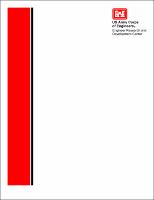Please use this identifier to cite or link to this item:
https://hdl.handle.net/11681/7495Full metadata record
| DC Field | Value | Language |
|---|---|---|
| dc.contributor.author | Heath, Ronald E. | - |
| dc.contributor.author | Fagerburg, Timothy L. | - |
| dc.contributor.author | Parchure, T. M. (Trimbak Mukund), 1943- | - |
| dc.contributor.author | Teeter, Allen M. | - |
| dc.contributor.author | Boyt, William L. | - |
| dc.date.accessioned | 2016-05-06T14:32:59Z | - |
| dc.date.available | 2016-05-06T14:32:59Z | - |
| dc.date.issued | 2000-09 | - |
| dc.identifier.uri | http://hdl.handle.net/11681/7495 | - |
| dc.description | Technical report | - |
| dc.description | A field data collection effort was initiated on 4 June 1994 to monitor water-level fluctuations, suspended sediment concentrations, and bottom material sampling for sediment classification. Water level fluctuations, at 15-min sampling intervals, were obtained at four locations using continuous recording water level sensors. Water samples, obtained during a significant water level rise, were collected using float activated automatic water samplers. Bottom material samples were obtained using two types of sampling devices. A 6-in. box core sampler, for collecting undisturbed samples, and a push core sampler, for collecting samples for subsectioning, were the devices used. River current measurements were performed at four data collection ranges. Acoustic Doppler Current Profile (ADCP) equipment were used to obtain the velocity data. Monthly service trips were scheduled to perform maintenance and data retrieval on the long-term equipment. Preliminary data analysis of velocity profiles indicated the velocity range was 0 - 30 cm/sec. Laboratory erosion tests indicated the critical shear stress for commencement of surface erosion between 0.2 - 0.6 Pa. A preliminary TABS-MD finite element modeling system was developed to provide multidimensional solutions to open-channel flow and sediment transport problems. Finite element meshes were developed using National Oceanic and Atmospheric Administration (NOAA) survey chart of the area and recent hydrographic survey data collected by the U.S. Army Engineer District, Detroit. Typical mesh element size was 120 m (400 ft) longitudinally and 18 m (60 ft) laterally. | - |
| dc.publisher | Coastal and Hydraulics Laboratory (U.S.) | - |
| dc.publisher | Engineer Research and Development Center (U.S.) | - |
| dc.relation | http://acwc.sdp.sirsi.net/client/en_US/search/asset/1000593 | - |
| dc.relation.ispartofseries | ERDC/CHL TR; 99-9 rept. 1. | - |
| dc.rights | Approved for public release; distribution is unlimited. | - |
| dc.source | This Digital Resource was created from scans of the Print Resource | - |
| dc.subject | Acoustic Doppler Current Profiler (ADCP) | - |
| dc.subject | Bed sediments | - |
| dc.subject | Bed shear stress | - |
| dc.subject | Field data collection | - |
| dc.subject | Hydrodynamic model | - |
| dc.subject | Lake Erie | - |
| dc.title | Ashtabula River, Ohio, sedimentation study. Report 1, Field and numerical model investigations of channel scour: 1994 interim results | - |
| dc.type | Report | en_US |
| Appears in Collections: | Technical Report | |
Files in This Item:
| File | Description | Size | Format | |
|---|---|---|---|---|
| TR-CHL-99-9-1.pdf | 618.57 kB | Adobe PDF |  View/Open |